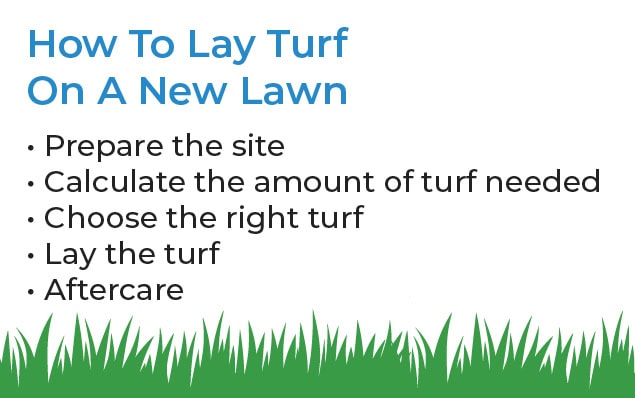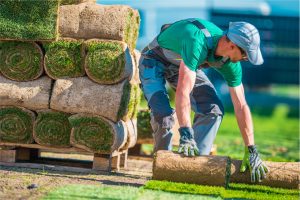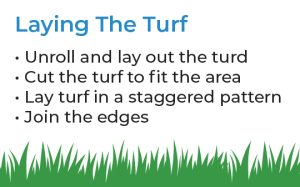How To Lay Turf On A New Lawn: A Step-by-Step Guide
Have you been yearning for a luscious new lawn, but don’t know how to lay turf? Do you wish you knew more about the process of laying turf? Well, you’re reading the right article!
Turf laying is crucial in creating an attractive outdoor space, because a newly laid lawn makes for a fantastic inclusion within any property, whether residential or commercial. While you may not know how to lay grass, in truth, it is a process that can be undertaken as a DIY project when you have access to the right information and make use of high-quality turf.
Centring around a five-step process, turf installation should always be completed with a focus on quality over speed, because all returfing projects come at some time and cost. Nevertheless, by carefully preparing the site, accurately calculating the amount of turf that is required, choosing the right variety and completing the installation process carefully, the new lawn you achieve will be of high quality.
To help you achieve these fantastic results, the team at Andrews Turf has devised this informative guide to give you all the information you need to lay rolls of turf with precision and accuracy.

Turf On A New Lawn
Preparing The Site
Before you begin the process of installing your new turf, it’s important to take a number of steps to prepare the site.
-
Remove Existing Grass and Vegetation
A vital part of the process is removing any existing grass and weeds from the lawn to ensure your new turf can be laid in an uninterrupted environment. Hence, any vegetation present within the area must also be removed to ensure the it is free from any obstructions.
-
Level The Soil
Following this, the soil within the area must be levelled to ensure your new lawn can be laid at a consistent height. This can be done by removing any excess soil, and also by adding any soil required to account for inconsistencies in its level throughout the new lawn. When you do begin the process of laying lawn turf, it’s crucial to double check that the surface is level, because this provides a sound foundation for the new turf and ensures a proper drainage system is in operation, while also making for an aesthetically pleasing end result.
-
Add Topsoil If Necessary
While it’s important to have a level soil surface, the existing soil may not be suitable for the new turf as it may be infertile, too compact, or not offer proper drainage. In this instance, topsoil may need to be added to the new lawn to ensure the grass is offered a solid foundation upon which a healthy root system can develop.
Calculating The Amount of Turf Needed
If you’ve been wondering “how much turf do I need”, don’t worry, that’s the next step in the process! Once you have adequately prepared the site for the installation of new turf, you’ll move on to calculate the amount of turf that will be needed for the project. This step in the process is very influential in determining the cost of turfing a garden, but naturally, this depends on the amount of turf that you require.
-
Measure The Area
To determine the number of rolls of grass that you need, you’ll need to measure the square footage of the space that you will be laying grass on. This will see you measure the length and width of this area, and multiplying these numbers together will yield the square footage.
-
Determine How Many Rolls of Turf Are Needed
Once you have determined the square footage, you’ll need to calculate the number of rolls of grass that will be required for the project. This can be determined by dividing the total square footage by the area that you will be returfing. The figure that this equation yields will be the number of turf rolls that will be needed.

turf rolls
-
Account For Wastage and Cutting
When this has been calculated, you must then account for the wastage that will inevitably occur when laying a new lawn. To navigate around natural obstructions such as fences, plants and bushes, as well as the shape of the area, adding an extra 5% to the amount of new turf you purchase is recommended.
Choosing The Right Turf
The next step in achieving a newly laid lawn is choosing the most appropriate variation of turf. This decision also has a big impact on the cost of turfing a garden, as naturally, not all variations come at the same cost. When you do proceed to buy lawn turf for your next returfing project, it’s important to consider the environment in which you will be laying grass.
-
Consider Your Climate
Climate is an important factor to consider because some variations of grass, such as Sir Walter Buffalo grass, are particularly versatile and can withstand extreme heat, shade and drought, while others require specialised care and are sensitive to changes in temperature and moisture levels.
-
Account For Your Traffic
You must also consider the amount of traffic that the newly laid lawn will be subjected to, as certain lawn variations are very hard-wearing, while others may deteriorate more easily. The amount of shade and sunlight within available must also be considered, as this may compromise the quality of your installation process.
-
Find A Reputable Supplier
When you’ve decided which turf variation best meets your needs, it’s important to find a reputable turf supplier. To make sure you opt for the best supplier, it’s a good idea to read their reviews and consider how much they charge for a roll of grass, ensuring it remains within your budget. At Andrew’s Turf, we supply a wide range of different grass variations that you can use in your next returfing project, and we’re always happy to assist in the installation process should you require any help.

Laying The Turf
Whether you are undertaking a returfing project or laying a new lawn entirely, a number of steps must be carefully followed to ensure a high quality result is achieved.
-
Unroll and Lay Out The Turf
The first step in the process is to carefully unroll the rolls of turf. It’s important for this to be done early on, because turf is a living being that requires sufficient nutrients. By leaving turf in a rolled position for an extended period of time, you put the new turf at risk of sustaining damage that will compromise its quality. As such, it’s important for the turf to be rolled out directly onto the area of the prepared soil that it will sit.
-
Cut Turf To Fit The Area
Once the new turf has been laid, it must be cut to fit the area that it will occupy. This must not be done hastily, because any mistakes in this process can result in visible ridges within the new turf or irregularities in its pattern. Before any cuts are made, it’s crucial that the area is measured precisely, and following this, a sharp blade or turf cutter can be used to make the required cuts.
-
Lay Turf In A Staggered Pattern
Additionally, the turf must also be laid in a staggered pattern to ensure it achieves a natural look, making for an aesthetically pleasing result. Staggering the installation makes sure the joints in the turf are less noticeable, but beyond these cosmetic considerations, it also ensures the joints are tightly bonded together, making the seams less likely to separate. This also makes the growth of vegetation and weeds less likely to occur, creating a more consistent surface.
-
Join The Edges
The final step in the process of laying turf is to join its edges together. Once the rolls of turf have been laid, a seamless end product can be ensured by joining their edges together. Joiner pegs are often used in this process, as the edges of the turf must overlap to ensure they are bound together sufficiently. While this process does ensure a more visually appealing finish, it also prevents separation in future.
Aftercare
Now that your newly laid lawn has reached completion, you might be thinking the job is done. However, the grass laying process must be followed up with a consistent schedule of maintenance to ensure it maintains its quality.
-
Consistent Watering
A regular watering schedule is important as this ensures the roots are given the required nutrients to form and bond. A deep water every day for the first three weeks is advisable, as this will ensure a consistent moisture level is maintained. This gives the new turf a more predictable environment to adapt to and prevents any disruptions to its growth and root development.
-
Regular Mowing Schedule
Once the grass has been laid, it’s also important to give it sufficient time to settle and adjust to its new surroundings and environment. Hold off from mowing it until 4-6 weeks after its installation, and be sure to not cut it too short initially, as this may weaken its structure.
-
Looking To The Future
Once the grass has settled into its new environment, it’s important to keep up with a regular maintenance schedule, mowing and watering the grass on a consistent basis throughout the seasons and using weed control measures when necessary.
Still Need Some Help?
By following these detailed steps, you next returfing project should be a complete success. However, if you do require any assistance throughout any part of the process, the team at Andrews Turf are always available to offer you any assistance you may require.

Turf Experts